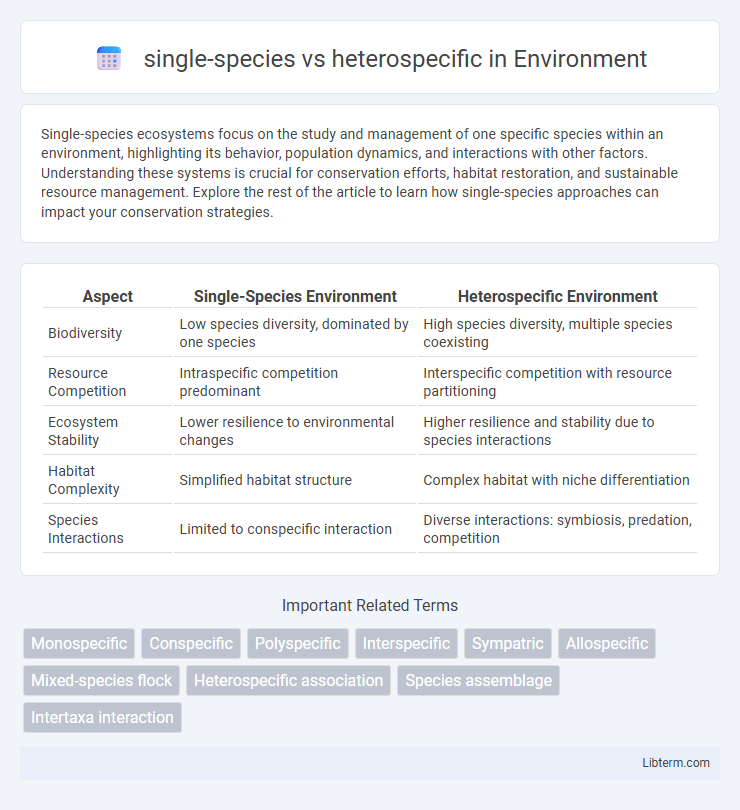Single-species ecosystems focus on the study and management of one specific species within an environment, highlighting its behavior, population dynamics, and interactions with other factors. Understanding these systems is crucial for conservation efforts, habitat restoration, and sustainable resource management. Explore the rest of the article to learn how single-species approaches can impact your conservation strategies.
Table of Comparison
| Aspect | Single-Species Environment | Heterospecific Environment |
|---|---|---|
| Biodiversity | Low species diversity, dominated by one species | High species diversity, multiple species coexisting |
| Resource Competition | Intraspecific competition predominant | Interspecific competition with resource partitioning |
| Ecosystem Stability | Lower resilience to environmental changes | Higher resilience and stability due to species interactions |
| Habitat Complexity | Simplified habitat structure | Complex habitat with niche differentiation |
| Species Interactions | Limited to conspecific interaction | Diverse interactions: symbiosis, predation, competition |
Introduction to Species Interactions
Species interactions shape ecological communities by influencing survival, reproduction, and resource availability among organisms. Single-species interactions involve intraspecific competition, where individuals of the same species compete for limited resources, affecting population dynamics and genetic diversity. Heterospecific interactions, such as predation, mutualism, and interspecific competition, occur between different species and drive evolutionary adaptations, community structure, and ecosystem functioning.
Defining Single-Species Communities
Single-species communities consist exclusively of individuals from one species, creating a uniform ecological environment that facilitates focused studies on intraspecific interactions and species-specific dynamics. In contrast, heterospecific communities comprise multiple species, promoting complex interspecific relationships such as competition, predation, and mutualism. Understanding single-species communities enables precise analysis of population growth, resource use, and evolutionary adaptations without the confounding effects of species diversity.
Understanding Heterospecific Associations
Heterospecific associations involve interactions between individuals of different species, often enhancing survival through shared resources or predator avoidance. These associations can lead to mutual benefits such as increased foraging efficiency and improved vigilance compared to single-species groups. Understanding the dynamics of heterospecific interactions is crucial for ecological studies on community structure and species coexistence.
Ecological Roles of Single-Species Groups
Single-species groups play a critical role in ecosystems by maintaining population stability and ensuring species-specific resource utilization, which reduces interspecific competition. These groups contribute to niche specialization, promoting biodiversity through distinct ecological functions such as pollination, seed dispersal, or predation within their unique habitats. Their cohesiveness enhances social behaviors and cooperative interactions that can improve survival rates and reproductive success, ultimately supporting ecosystem resilience.
Benefits of Heterospecific Interactions
Heterospecific interactions enhance biodiversity by promoting resource sharing and reducing intraspecific competition among different species. These interactions facilitate mutualistic relationships, such as pollination and seed dispersal, which improve ecosystem productivity and resilience. Increased species diversity through heterospecific associations supports habitat stability and aids in buffering environmental changes.
Competition Dynamics: Single vs. Heterospecific
Competition dynamics in single-species populations often lead to intense intraspecific competition for limited resources such as food, shelter, and mates, which can regulate population size and drive natural selection. In contrast, heterospecific competition involves interactions between different species competing for similar ecological niches, often resulting in niche differentiation or competitive exclusion to minimize overlap. Studies show that heterospecific competition can promote biodiversity by encouraging species to specialize or adapt, whereas single-species competition more directly influences density-dependent population regulation.
Adaptation and Evolutionary Implications
Single-species interactions drive specialization, promoting adaptations tightly aligned with specific ecological niches and leading to increased genetic homogeneity. Heterospecific interactions introduce diverse selective pressures, fostering broader adaptive traits and enhancing evolutionary plasticity. This diversity in evolutionary pathways supports ecosystem resilience and promotes coevolutionary dynamics across multiple species.
Impact on Ecosystem Functioning
Single-species systems often exhibit limited biodiversity, potentially reducing ecosystem resilience and nutrient cycling efficiency. Heterospecific communities enhance ecosystem functioning through complementary resource use, increased productivity, and greater stability against environmental disturbances. Diverse species interactions in heterospecific assemblages promote complex trophic dynamics and support essential ecosystem services such as pollination, soil fertility, and carbon sequestration.
Case Studies: Real-World Examples
In single-species studies, research on African elephants has documented how intraspecific competition affects resource allocation and social hierarchy. Heterospecific studies, such as those involving coral reef fish, reveal interspecies interactions shaping community diversity and predator-prey dynamics. Case studies on mixed-species bird flocks demonstrate benefits like enhanced foraging efficiency and improved predator detection, exemplifying ecological advantages of heterospecific associations.
Future Perspectives and Research Directions
Future research in single-species and heterospecific interactions emphasizes advanced genomic and ecological modeling techniques to unravel species-specific adaptation mechanisms and interspecies dynamics. Integrating multi-omics data and environmental variables will enhance predictive accuracy in ecosystem resilience and biodiversity conservation strategies. Emphasis on cross-disciplinary approaches aims to refine species interaction networks, facilitating targeted management and restoration efforts in changing climates.
single-species Infographic

 libterm.com
libterm.com